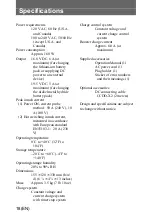
7(EN)
• When you attempt to charge a battery pack which has never
been charged before, the actual charging amount stays less
than 80% of nominal capacity*.
* Average capacity when a single cell is charged at 0.1C for 16 hours and
discharged at 0.2C.
• Charging of the nickel metal hydride battery pack when an
ambient temperature or the temperature of the battery pack
itself is more than 30˚C (50˚F), charging time will be longer
and charge amount will be less than the case of charging with
ambient or the battery pack temperature between 10˚C and
30˚C (50˚F and 86˚F).
When charging with temperature of 40˚C (104˚F), charging
finishes with 80% of full capacity. In this case, recharging is
possible with temperature of 30˚C (50˚F) or less. Note that
recharging is only possible for battery packs whose remaining
capacity is 90% or less to prevent excessive recharging.
Lithium-ion battery packs are free from memory effect.
There is no need to discharge them fully before recharging.
If the usable time of a battery pack becomes very short, it is
time to replace it with a new one.
Battery pack charge indicators at high or low
temperatures
The battery pack cannot be charged when it is too hot or too
cold. If a charge indicator at the top of the battery charger
(figure below) flashes orange, it means that the battery pack
temperature is above or below a given standard and that the
charger is waiting for the battery pack to return to a
temperature at which charging is possible. If the battery pack
does not return to the standard temperature within a given time,
an error arises and charging is not carried out.
Charge Indicators
Left
Center
Right
: flashing orange
: off
















































